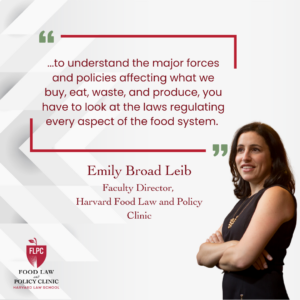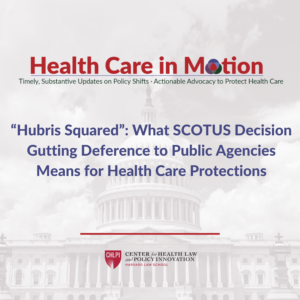Originally published on April 1, 2020 by Farm Bill Law Enterprise (FBLE). Written by Juston Jaco, FLPC student.
While it’s currently a challenge not to keep up with the latest developments on COVID-19, you might not know that states have been tirelessly submitting requests to the federal government for major disaster declarations. At the time of this writing, New York, California, Washington, Louisiana, Iowa, New Jersey, Georgia, Oregon, Connecticut, Kentucky, South Carolina, Missouri, Maryland, Illinois, Florida, Texas, Colorado, Michigan, and Massachusetts, as well as Guam and Puerto Rico, have received approval of their disaster declarations. These declarations have several implications for feeding the most vulnerable populations in the U.S., especially those with electronic benefit transfer (EBT) (i.e., enrolled in the Supplemental Nutrition Assistance Program (SNAP)).
After a natural disaster, and at the request of a state’s governor, the president may issue a Declaration of a Major Disaster when the state’s capacity to offer emergency services is overwhelmed, typically during severe weather events or other naturally occurring phenomena. Following a major disaster declaration, the federal government can provide three types of assistance: individual assistance, public assistance, and hazard mitigation assistance. The official declaration entitles the state to implement a broad range of federal assistance during its relief efforts. One program available under individual assistance is the Disaster Supplemental Nutrition Assistance Program (D-SNAP).
As the Food Research & Action Center explains: “The federal Robert T. Stafford Disaster Relief and Emergency Assistance Act authorizes the president to establish D-SNAP following a disaster declaration, and Executive Order [No. 11795, as amended under Executive Order No. 12673,] delegates this authority to the Secretary of Agriculture. This means that following a presidential declaration of a disaster, USDA may conduct D-SNAP without the president’s further approval or involvement.” States then work with USDA to evaluate options for providing relief and may request authorization of D-SNAP as one of those mechanisms. Importantly, D-SNAP approval requires that normal channels of food distribution (i.e., grocery stores or semi-operational grocery supermarkets) be functioning in order to successfully and efficiently feed the affected individuals, and, ultimately, provide an economic boost to the hardest hit communities. D-SNAP allows for broad state and local government discretion to deliver food and benefits for purchasing food to those affected by the disaster.
The original purpose of D-SNAP was to extend EBT benefits to households that would not normally be eligible for—but suddenly need—rapid food assistance after a major disaster. Hence, qualifying participants who already receive SNAP benefits could get more aid (up to the maximum monthly allotment) while those who did not previously qualify could obtain D-SNAP benefits without the onerous delays in verification and reporting requirements. Expanding food assistance quickly eases the administrative burden on affected states. While D-SNAP is generally limited to a one-time payment for food assistance, it may be extended in extraordinary circumstances (i.e. prolonged periods of food insecurity well after a major disaster declaration). Other non-food, disaster-related expenses can be deducted from income and resources when determining an applicant’s eligibility to receive disaster aid.
In the past, D-SNAP has been used following natural disasters like flooding, fires, and storms, but not for a public health pandemic like the one we are now experiencing.
Yet, in the wake of COVID-19, policymakers have sought ways of counteracting food insecurity. In a matter of days, state-wide closures caused a series of events to happen one after the other—a veritable domino effect—that made us wonder how vulnerable populations would get access to food assistance. Because measures to reduce the spread of COVID-19 include decreasing interactions between individuals (known collectively as “social distancing”), we witnessed how deeply isolation interfered with the food supply, including children missing school meals, parents losing pay and access to food, and other basic necessities being cut off.
The chain reaction was so strongly felt that Congress created a whole new SNAP, called Pandemic SNAP (P-SNAP). Similar to a special version of SNAP authorized during the A/H1N1 outbreak of 2009 (and since expired), P-SNAP essentially fills the food gaps after schools close. The recent Congress-authorized program provides EBT benefits to students, and (potentially) their families, who receive free and reduced price school meals. According to the Families First Coronavirus Response Act, “[d]uring fiscal year 2020, in any case in which a school is closed for at least 5 consecutive days during a public health emergency designation during which the school would otherwise be in session, each household containing at least 1 member who is an eligible child attending the school shall be eligible to receive assistance pursuant to a state agency plan.”
States must elect to participate in P-SNAP and submit plans to the United States Department of Agriculture (USDA) for approval. The USDA has issued guidance on state plans and all states should submit their plans as quickly as possible so that they can begin enrolling individuals—and avoid delays—in the difficult weeks ahead. For the 40+ million people living in food-insecure households, this P-SNAP paramount.
Once approved to operate P-SNAP, states would allow every household with at least one student on free and reduced school meals to be eligible for new EBT benefits. These benefit levels are set by USDA and cannot be less than the value of free breakfast and lunch over the course of five school days for each eligible child in the household. States are to distribute these benefits to families in monthly allotments, based on the average number of cancelled school days or average date for the end of school closure. In other words, this helps account for lost school meals. Households will need to complete an application with their state agency to enroll. More information on the process is soon to come, but the USDA should provide technical assistance to states that submit P-SNAP plans and approve plans right away.
The D-SNAP and P-SNAP programs reflect the unpredictability of an endlessly interconnected world, and, one by one, states are declaring major disasters because all types of assistance are needed at this time. D-SNAP and P-SNAP are a small but vital part of the support needed to keep the families fed amidst the spread of COVID-19. Both catastrophic and pandemic situations are disasters in their own right and have significant public health complications. Because the President has already declared major disasters in the states listed above—with others likely on the way—there appears to be little stopping USDA and individual states from implementing D-SNAP in the coming weeks or months. In order to expedite the availability of D-SNAP nationwide, the President should issue a national declaration of “Major Disaster Assistance.” Once declared, states should uniformly work with the USDA and FEMA to make D-SNAP benefits available to their communities. At that point, P-SNAP and D-SNAP can work in tandem to help alleviate food insecurity during this trying time.
Juston Jaco, M.Sc., is a Master of Public Health candidate at the Harvard T.H. Chan School of Public Health and currently enrolled in the Harvard Law School Food Law and Policy Clinic.
For additional Congressional opportunities to combat food insecurity, see HLS Food Law & Policy Clinic’s Issue Brief, Feeding People in their Homes: Opportunities to Bolster Home Food Delivery for Vulnerable Communities.
The views reflected in this blog are those of the individual authors and do not necessarily represent those of the Center for Health Law & Policy Innovation or Harvard Law School. This blog is solely informational in nature, and not intended as a substitute for competent legal advice from a licensed and retained attorney in your state or country.


Health Law & Policy, Commentary
Braidwood Management v. Becerra: Updated FAQs for Health Advocates and Providers
July 22, 2024